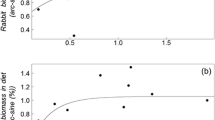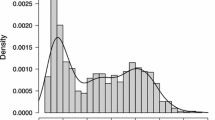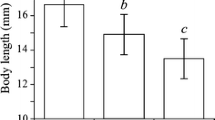Abstract
How predators impact on prey population dynamics is still an unsolved issue for most wild predator–prey communities. When considering vertebrates, important concerns constrain a comprehensive understanding of the functioning of predator–prey relationships worldwide; e.g. studies simultaneously quantifying ‘functional’ and ‘numerical responses’ (i.e., the ‘total response’) are rare. The functional, the numerical, and the resulting total response (i.e., how the predator per capita intake, the population of predators and the total of prey eaten by the total predators vary with prey densities) are fundamental as they reveal the predator’s ability to regulate prey population dynamics. Here, we used a multi-spatio-temporal scale approach to simultaneously explore the functional and numerical responses of a territorial predator (Bonelli’s eagle Hieraaetus fasciatus) to its two main prey species (the rabbit Oryctolagus cuniculus and the red-legged partridge Alectoris rufa) during the breeding period in a Mediterranean system of south Spain. Bonelli’s eagle responded functionally, but not numerically, to rabbit/partridge density changes. Type II, non-regulatory, functional responses (typical of specialist predators) offered the best fitting models for both prey. In the absence of a numerical response, Bonelli’s eagle role as a regulating factor of rabbit and partridge populations seems to be weak in our study area. Simple (prey density-dependent) functional response models may well describe the short-term variation in a territorial predator’s consumption rate in complex ecosystems.




Similar content being viewed by others
References
Abrams P, Ginzburg LR (2000) The nature of predation: prey dependent, ratio dependent or neither. Trends Ecol Evol 15:337–341
Andersson M, Erlinge S (1977) Influence of predation on rodent populations. Oikos 29:591–597
Angerbjörn A et al (1999) Predator-prey relationships: arctic foxes and lemmings. J Anim Ecol 68:34–49
Bergström U, Englund G (2004) Spatial scale, heterogeneity and functional responses. J Anim Ecol 73:487–493
Blanco JC (1998) Mamíferos de España. Vol. II. Cetáceos, Artiodáctilos, Roedores y Lagomorfos de la Península Ibérica, Baleares y Canarias. Editorial Planeta, Barcelona
Bosch R, Real R, Tintó A, Zozaya EL, Castell C (2010) Home-ranges and patterns of spatial use in territorial Bonelli’s eagles Aquila fasciata. Ibis 152:105–117
Boutin S (1995) Testing predator–prey theory by studying fluctuating populations of small mammals. Wildl Res 22:89–100
Buckland ST, Anderson DR, Burnham KP, Laake JL, Borchers DL, Thomas L (2004) Advanced distance sampling. Oxford University Press, Oxford
Cheylan G (1981) Sur le role determinant de l′abondance des ressources dans le succés de reproduction de l′Aigle de Bonelli Hieraaetus fasciatus en Provence. Rapaces Mediterr 1:95–99
Clouet M, Goar JL (1984) Relation morphologie-ecologie entre l′aigle royal (Aquila chrysaetos) et l′aigle de Bonelli (Hieraaetus fasciatus). Especies sympatriques dans le midi de la france. Rapaces Mediterr 2:109–119
del Hoyo J, Elliot A, Sargatall J (eds) (1994) Handbook of the birds of the world. Vol. 2. New Vultures to Guineafowl. Lynx Editions, Barcelona
Erlinge S, Goransson G, Hansson L, Hogstedt G, Liberg O, von Nilsson I, Schantz T, Sylven M (1983) Predation as a regulating factor on small rodent populations in southern Sweden. Oikos 50:347–352
Fernández A, Román J, de la Torre JA, Ansola LM, Santa María J, Ventosa R, Román F, Palma C (1998) Demografía y conservación de una población de Águila Perdicera Hieraaetus fasciatus en declive. In: Meyburg BU, Chancellor RD, Ferrero JJ (eds) Holarctic birds of prey. Proceedings of an International Conference. ADENEX-WWGBP, Calamonte, pp 305–322
Futuyma DJ, Moreno G (1988) The evolution of ecological specialization. Annu Rev Ecol Syst 19:207–233
Gilg O, Sittler B, Sabard B, Hurstel A, Sané R, Delattre P, Hanski I (2006) Functional and numerical responses of four lemming predators in high arctic Greenland. Oikos 113:193–216
Gil-Sánchez JM (1998) Selección de presa por el Águila Perdicera (Hieraaetus fasciatus) durante el periodo de nidificación en la provincia de Granada (SE de España). Ardeola 45:151–160
Gil-Sánchez JM (2000) Efecto de la altitud y la disponibilidad de presas en la fenología de puesta del Águila-azor Perdicera (Hieraaetus fasciatus) en la provincia de Granada (SE de España). Ardeola 47:1–8
Gil-Sánchez JM, Valenzuela G, Sánchez JF (1999) Iberian wild cat Felis silvestris tartessia predation on rabbit Oryctolagus cuniculus: functional response and age selection. Acta Theriol 44:421–428
Gil-Sánchez JM, Moleón M, Otero M, Bautista J (2004) A nine-year study of successful breeding in a Bonelli’s eagle population in southeast Spain: a basis for conservation. Biol Conserv 118:685–694. doi:10.1016/j.biocon.2003.10.017
Griffen BD, Byers JE (2006) Intraguild predation reduces redundancy of predator species in multiple predator assemblage. J Anim Ecol 75:959–966
Hanski I, Hansson L, Henttonen H (1991) Specialist predators, generalist predators and the microtine rodent cycle. J Anim Ecol 60:353–367
Hansson L, Henttonen H (1985) Gradients in density variations of small rodents: the importance of latitude and snow cover. Oecologia 67:394–402
Holling CS (1959) The components of predation as revealed by a study of small mammal predation on the European pine sawfly. Can Entomol 91:293–320
Holling CS (1965) The functional response of predators to prey density and its role in mimicry and population regulation. Entomol Soc Can Mem 45:3–60
Iezekiel S, Bakaloudis DE, Vlachos CG (2004) The diet of the Bonelli’s eagle Hieraaetus fasciatus, in Cyprus. In: Chancellor RD, Meyburg BU (eds) Raptors worldwide. WWGBP/MME, Berlin, pp 581–587
Ives AR, Schooler SS, Jagar VJ, Knuteson SE, Grbic M, Settle WH (1999) Variability and parasitoid foraging efficiency: a case study of pea aphids and Aphidius ervi. Am Nat 154:652–673
Jacksić FM, Jiménez JE, Castro SA, Feinsinger P (1992) Numerical and functional response of predators to a long-term decline in mammalian prey at a semi-arid Neotropical site. Oecologia 89:90–101
Jeschke JM, Kopp M, Tollrian R (2002) Predator functional responses: discriminating between handling and digesting prey. Ecol Monogr 72:95–112
Joly DO, Patterson BR (2003) Use of selection indices to model the functional response of predators. Ecology 84:1635–1639
Jovani R, Tella JL (2006) Parasite prevalence and sample size: misconceptions and solutions. Trends Parasitol 22:214–218
Korpimäki E, Norrdahl K (1989) Predation of Tengmalm’s owls: numerical responses, functional responses and dampening impact on population fluctuations of microtines. Oikos 54:154–164
Krebs CJ, Boutin S, Boonstra R (2001) Ecosystem dynamics of the boreal forest. Oxford University Press, Oxford
Marshal JP, Boutin S (1999) Power analysis of wolf-moose functional responses. J Wildl Manage 63:396–402
May RM (1973) Stability and complexity in model ecosystems. Princeton University Press, Princeton
May RM (1981) Models for two interacting populations. In: May RM (ed) Theoretical ecology, principles and applications, 2nd edn. Blackwell, London, pp 78–104
Messier F (1995) On the functional and numerical responses of wolves to changing prey density. In: Carbyn LN, Fritts SH, Seip DR (eds) Ecology and conservation of wolves in a changing world. Canadian Circumpolar Institute, Edmonton, Alberta, pp 187–197
Moleón M (2006) El águila perdicera en Andalucía. In: del Moral JC (ed) El águila perdicera en España. Población en 2005 y método de censo. SEO/Birdlife, Madrid, pp 24–49
Moleón M, Gil-Sánchez JM, Real J, Sánchez-Zapata JA, Bautista J, Sánchez-Clemot JF (2007) Non-breeding feeding ecology of territorial Bonelli’s eagles Hieraaetus fasciatus in the Iberian Peninsula. Ardeola 54:135–143
Moleón M, Almaraz P, Sánchez-Zapata JA (2008) An emerging infectious disease triggering large-scale hyperpredation. PLoS One 3:e2307. doi:10.1371/journal.pone.0002307
Moleón M, Sánchez-Zapata JA, Real J, García-Charton JA, Gil-Sánchez JM, Palma L, Bautista J, Bayle P (2009) Large scale spatio-temporal shifts in the diet of a predator mediated by an emerging infectious disease of its main prey. J Biogeogr 36:1502–1515. doi:10.1111/j.1365-2699.2009.02078.x
Moleón M, Sánchez-Zapata JA, Gil-Sánchez JM, Barea-Azcón JM, Ballesteros-Duperón E, Virgós E (2011) Laying the foundations for a human-predator conflict solution: assessing the impact of Bonelli’s eagle on rabbits and partridges. PLoS One 6:e22851. doi:10.1371/journal.pone.0022851
Nachman G (2006) A functional response model of a predator population foraging in a patchy habitat. J Anim Ecol 75:948–958
Newton I (1998) Population limitation in birds. Academic, London
Nielsen OK (1999) Gyrfalcon predation on ptarmigan: numerical and functional responses. J Anim Ecol 68:1034–1050
O’Donoghue M, Boutin S, Krebs CJ, Hofer EJ (1997) Numerical responses of coyotes and lynx to the snowshoe hare cycle. Oikos 80:150–162
O’Donoghue M, Boutin S, Krebs CJ, Zuleta G, Murria DL, Hofer EJ (1998) Functional responses of coyotes and lynx to the snowshoe hare cycle. Ecology 79:1193–1208
Ontiveros D, Pleguezuelos JM (2000) Influence of prey densities in the distribution and breeding success of Bonelli’s eagle (Hieraaetus fasciatus): management implications. Biol Conserv 93:19–25
Palma L, Beja P, Pais M, Cancela da Fonseca L (2006) Why do raptors take domestic prey? The case of Bonelli’s eagle and pigeons. J Appl Ecol 43:1075–1086
Palomares F, Delibes M, Revilla E, Calzada J, Fedriani JM (2001) Spatial ecology of Iberian lynx and abundance of European rabbits in southwestern Spain. Wildl Monogr 148:1–36
Parellada X, de Juan A, Alemany O (1984) Ecologia de l′aliga cuabarrada (Hieraaetus fasciatus): factors limitants, adaptacions morfológiques i ecológiques i relacions interespecífiques amb l′aliga daurada (Aquila chrysaetos). Rapaces Mediterr 2:121–141
Pech RP, Sinclair ARE, Newsome AE, Catling PC (1992) Limits to predator regulation of rabbits in Australia: evidence from predator-removal experiments. Oecologia 89:102–112
Real J (1991) L′aliga perdiguera Hieraaetus fasciatus a Catalunya: status, ecologia trófica, biología reproductora i demografía. PhD thesis, University of Barcelona, Barcelona
Real J (1996) Biases in diet study methods in the Bonelli’s eagle. J Wildl Manag 60:632–638
Redpath SM, Thirgood SJ (1999) Numerical and functional responses in generalist predators: hen harriers and peregrines on Scottish grouse moors. J Anim Ecol 68:879–892
Salo P, Korpimäki E, Banks PB, Nordström M, Dickman CR (2007) Alien predators are more dangerous than native predators to prey populations. Proc R Soc Lond B 274:1237–1243
Schmitz OJ (2007) Predator diversity and trophic interactions. Ecology 88:2415–2426
Sherrod PH (1994) Users guide for NLREG, nonlinear regression analysis program, Version 3.2. Phillip H Sherrod, Nashville
Sih A, Englund G, Wooster D (1998) Emergent impacts of multiple predators on prey. Trends Ecol Evol 13:350–355
Tellería JL (1986) Manual para el censo de los vertebrados terrestres. Raíces, Madrid
Thomas L, Laake JL, Strindberg S, Marques FFC, Buckland ST, Borchers DL, Anderson DR, Burnham KP, Hedley SL, Pollard JH, Bishop JRB, Marques TA (2006) Distance 5.0. Release “x”1. Research Unit for Wildlife Population Assessment, University of St Andrews, St Andrews (http://www.ruwpa.st-and.ac.uk/distance/)
Thompson HV, King CM (1989) The European rabbit. The history and biology of a successful colonizer. Oxford University Press, Oxford
Tornberg R, Korpimäki E, Jungell S, Reif V (2005) Delayed numerical response of goshawks to population fluctuations of forest grouse. Oikos 111:408–415
Trexler JC, McCulloch CE, Travis J (1988) How can the functional response best be determined? Oecologia 76:206–214
Turchin P (2003) Complex population dynamics. Monographs in population biology. Princeton University Press, Princeton
Valkama J, Korpimäki E, Arroyo B, Beja P, Bretagnolle V, Bro E, Kenward R, Mañosa S, Redpath SM, Thirgood S, Viñuela J (2005) Birds of prey as limiting factors of gamebird populations in Europe: a review. Biol Rev 80:171–203
Virgós E, Cabezas-Díaz S, Lozano J (2007) Is the wild rabbit (Oryctolagus cuniculus) a threatened species in Spain? Sociological constraints in the conservation of species. Biodivers Conserv 16:3489–3504
Weaver W, Shannon CE (1949) The mathematical theory of communication. Illinois University Press, Urbana
Acknowledgments
The prey censuses in 2002 and the radiotracking work were conducted with the support of the regional government of S Spain (Egmasa-Consejería de Medio Ambiente, Junta de Andalucía). J. Martín-Jaramillo and E. Ávila helped with the radiotracking work. M.M. obtained a postdoctoral grant from the Spanish Ministry of Education (Programa Nacional de Movilidad de Recursos Humanos del Plan Nacional de I + D+i 2008–2011) during the final stage of this paper. V. Penteriani, J. Valkama, C. Johnson and three anonymous reviewers made valuable criticisms on an earlier draft of this manuscript. J. Muddeman and H. Warburton improved the English. Finally, we would like to thank M. Chirosa for his continuous and unconditional support.
Author information
Authors and Affiliations
Corresponding author
Additional information
Communicated by Christopher Johnson.
Electronic supplementary material
Below is the link to the electronic supplementary material.
Rights and permissions
About this article
Cite this article
Moleón, M., Sánchez-Zapata, J.A., Gil-Sánchez, J.M. et al. Predator–prey relationships in a Mediterranean vertebrate system: Bonelli’s eagles, rabbits and partridges. Oecologia 168, 679–689 (2012). https://doi.org/10.1007/s00442-011-2134-6
Received:
Accepted:
Published:
Issue Date:
DOI: https://doi.org/10.1007/s00442-011-2134-6




